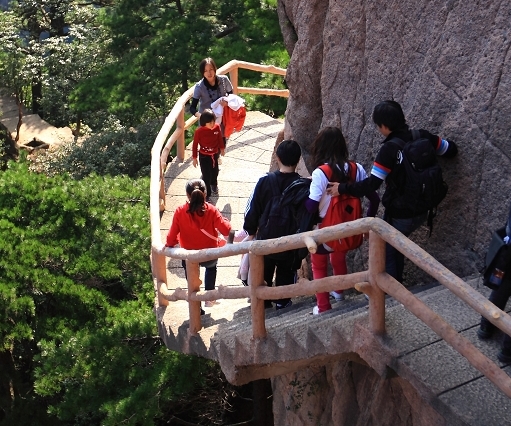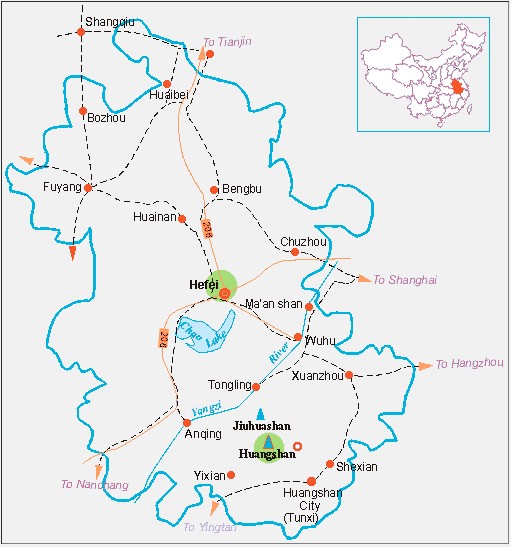
Mount Huangshan - a World Natural and Cultural Heritage site
Mount Huangshan, located in eastern China's Anhui Province and often described as the “loveliest mountain of China,” was inscribed on both the world cultural and natural heritage lists in 1990.
|
|
|
Location of?Mount Huangshan in Anhui Province |
The mountain is best renowned for its scenery in China, and has an interesting but complex geological history. It features numerous imposing peaks, whose formation dates back some 100 million years to the Mesozoic era, when the ancient Yangtse Sea disappeared as a result of crustal movements and subsequent uplift.

The geology and geomorphology of the region is undoubtedly of great interest; of particular note are the features resulting from glaciation, the folds and faults which have resulted from tectonic activity and the high altitude karst features including calcareous tufa shoals, waterfalls and stepped lakes.
Aesthetically, the site presents an almost unique spectacle, with its combined attraction of high mountains, forests, lakes, stepped lakes, waterfalls and calcareous shoals. The rich variety of colours is also notable, many of the lakes having clear blue, turquoise or green waters, while in autumn many of the leaves turn a range of rich colours.

?The site supports a high diversity of plant and animal species, including a number of that are threatened. U-shaped valleys, striations and boulders are evidence of later glaciation during the Quaternary period. Forests of stone pillars are numerous; other features include grotesquely shaped rocks, waterfalls, lakes and hot springs. The oldest rocks are the sedimentary deposits and metamorphic rocks from the Yangtse Sea, formed over 570 million years ago during the Proterozoic era and outcropping at the southern foot of Mount Huangshan and south of the Xiaoyaoxi fault.
Granite formations, formed during periods of orogenic activity, are characterized by well advanced longitudinal joints, responsible for the many impressive caves, ridges and gorges. Forests, characterized by Masson pine below 800 m and Huangshan pine from 800 m to 1,800 m, cover more than half the site. Predominantly evergreen moist forest occurs between 600 m and 1,100 m. Deciduous forest occurs from 1,100 m to 1,800 m, and alpine grassland above the tree line. Some 1,650 plant species have been recorded, of which about 1,450 are native and the rest have been introduced over the last twenty years. A number of trees are celebrated on account of their age, grotesque shape or precipitously perched position, including 1,000-year-old specimens of Huangshan pine, maidenhair tree (Ginkgo biloba ) and alpine juniper Sabina squamata .

The vertebrate fauna comprises 300 species and includes mammals, birds, reptiles, amphibians and fishes. A total of thirteen species is under state protection. Large mammals include rhesus and stump-tailed macaques, Asiatic black bear, wild dog, civet, Chinese ferret-badger, clouded leopard, wild boar, sika deer, mainland serow, red-bellied and spotted squirrels, and pangolin. Notable among the avifauna is the Oriental white stork.
The high esteem accredited to Huangshan throughout much of Chinese history has given rise to the Huangshan culture. Generation after generation, people have come to eulogize the mountain, resulting in a rich legacy of art and literature. Huangshan is considered to be a prime example of classic Chinese scenery, as typified in Chinese landscape paintings.
On 17 June 747, during the Tang dynasty, an imperial order was issued to name it Huangshan (Yellow Mountain). Until that time, however, the mountain had remained largely inaccessible from the outside world. Thereafter, poets, literary scholars and numerous other celebrities were among the many visitors, and by the Yuan dynasty (1271-1368) 64 temples had been constructed on the mountain. During the Ming dynasty, in 1606, Monk Pumen came to Huangshan and built Fahai Meditation Temple and Wonshu Temple, connecting them by steps cut into the mountain. Paintings and drawings of the mountain appeared as early as the mid-16th century. The inclusion of a number of Tibetan villages in the buffer zone adds to the cultural interest of the area.









